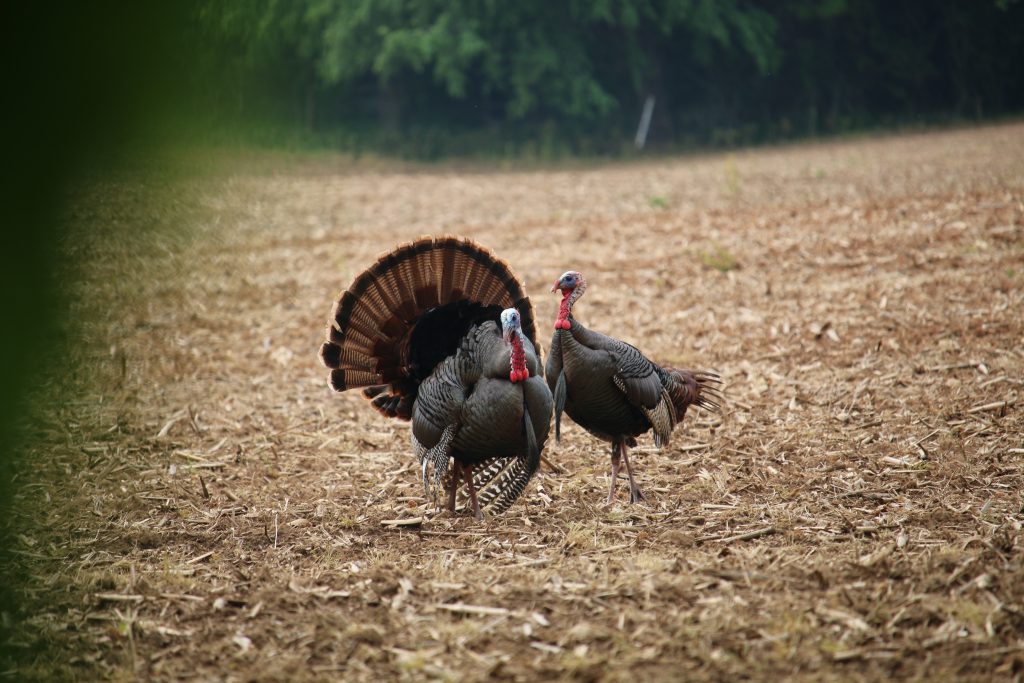Wild Turkey Body Language
Body language is an effective method by which turkeys communicate. In addition to emitted vocalizations, body language is another key way they communicate. As gregarious critters, it’s integral to their day-to-day activities.
Turkey hunters should pay attention to wild turkey body language for several reasons. Body language indicates mood and might even reveal a turkey’s near-term actions.
It also helps a hunter know what move they should make next: Whether or not to call, what calls to use, what decoy approach to utilize, and other important decisions are aided by observing wild turkey body language.
Head Coloration
The color of a turkey’s head indicates its state of mind. The typical coloration is red, white and blue. Generally, this is a gobbler feeling itself and having great confidence. Often, the more white displayed, the more dominant it feels. In contrast, the more red showing, the more fear or submission it’s expressing.
Hunting Application: Study the head coloration to know how aggressive your calling and decoying should be.

Snood Length
The length of the snood that hangs over the bird’s beak is another tell-tale sign of its mood. Generally, the more “into” the situation it is, the longer the snood will be. If it’s confident and sure of itself, it will extend down and over the beak. It will retract and shorten if it’s scared or unsure of the situation.
Hunting Application: Keep an eye on the snood to determine how the bird responds to calling and decoying.
Perescoping Head
A turkey sticking its neck up and stretching it out can mean several things. First and foremost, it can mean a turkey has seen something it doesn’t like. This might be a hunter, predator, etc. If you notice it turning its head sideways and peering upward, it’s possible the bird spotted an avian predator in the sky. If other toms and hens are around, it’s also possible the bird is attempting to look larger and more attractive.
Hunting Application: This can alert you to other turkeys or predators nearby, impacting how quickly you should take the shot.
Stretching
Like most animals, turkeys stretch. They stretch their head, wings and legs. Generally, this minimizes stress, but it can occur virtually anytime.
Hunting Application: A turkey that stretches might be stressed, but that isn’t always true. Stay on your toes and be ready.
Tail Flare
Often, when a predator is nearby, or in the moments leading up to a fight between two turkeys, male and female turkeys alike sometimes flair their tail feathers parallel to the ground to appear larger. This might also improve balance during the fight.
Hunting Application: This, too, can alert you to other turkeys or predators nearby, which can impact how quickly you should take the shot.
Strutting

A turkey that shows off to the turkeys around it tends to strut. This action ranges from ¼ strut to ½ strut to ¾ strut. The fuller the strut, the more confidence it has. Generally, this signifies greater dominance, too.
Hunting Application: How much a turkey is strutting is an essential indication of how a turkey is receiving your calling and decoying efforts.
The Spin and Walk-Off
In nature, the hens typically go to the toms. Because of this, toms oftentimes approach for a certain distance and then hang up. Then, generally, the hens close the distance. This is why toms frequently approach a set of decoys only to turn away and walk off.
Hunting Application: If a turkey does this, quit calling. Playing hard to get might turn the bird back around for a final and complete commitment to your setup.
Big Flaps
Turkeys that suddenly stop what they are doing, stretch their wings upward and do several wing flaps are often signaling to the flock they are leaving. Sometimes, it means they spotted something they don’t like. Other times, it just means it’s time to move on.
Hunting Application: If the turkey is in range, and you have a clear shot, take it. That bird is likely leaving.
Wing Flick
A turkey that suddenly stops what it’s doing and flicks and tucks its wings likely saw or heard something it didn’t like. It means that the bird is about to leave, and there isn’t anything you can do to stop it.
Hunting Application: As with the big flaps, it’s time to take the first shot opportunity. The turkey likely isn’t sticking around.
There are other subtle body language categories to remember, but the above list includes the most important things for most turkey hunters. Keep these in mind when heading afield on your next turkey hunt.
CONNECT WITH US
National Wild Turkey Federation
770 Augusta Road, Edgefield, SC 29824
(800) 843-6983
National Wild Turkey Federation. All rights reserved.
